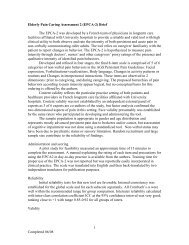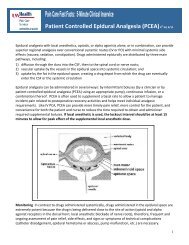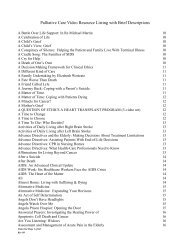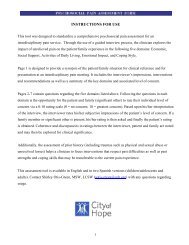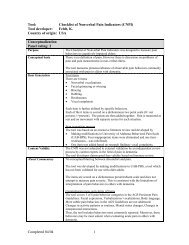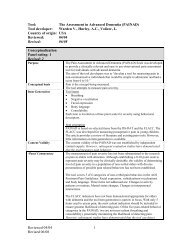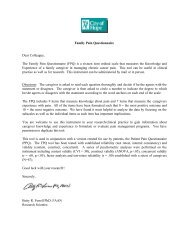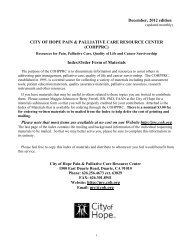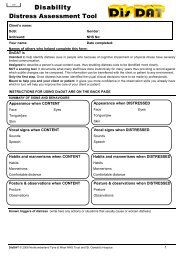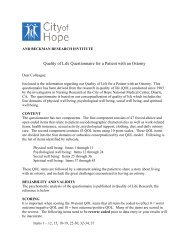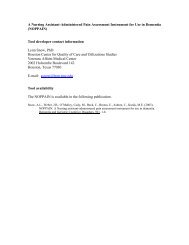Outline - Pain Resource Center
Outline - Pain Resource Center
Outline - Pain Resource Center
Create successful ePaper yourself
Turn your PDF publications into a flip-book with our unique Google optimized e-Paper software.
1<br />
Cancer <strong>Pain</strong> Education for Patients and the Public<br />
Module V<br />
Telephone Education - Informal Systems<br />
Pam Kedziera, RN, MSN, AOCN<br />
Faculty Member<br />
I. Application of Telephone Education to <strong>Pain</strong> Management<br />
A. Providing general pain information.<br />
1. AHCPR guidelines.<br />
2. Community <strong>Resource</strong> List.<br />
3. Referrals.<br />
B. Overcoming myths/misconceptions.<br />
1. Listen for clues.<br />
C. "Coaching" to support assessment and communication.<br />
1. Start with open-ended question - "Describe your pain".<br />
2. Proceed to specific questions - "When did it start?"<br />
D. Titration of pharmacologic interventions.<br />
1. Following current prescription order.<br />
2. Standing orders.<br />
3. Multiple incremental changes.<br />
E. Management of side effects.<br />
1. Constipation.<br />
a. bowel protocol.<br />
2. Sedation.<br />
3. Confusion<br />
4. Dizziness<br />
5. Rash<br />
F. Reinforcement of in-person education.<br />
1. Written pain therapy instruction.<br />
II.<br />
Benefits of Telephone Education<br />
A. More immediate response.<br />
B. Less threatening than medical environment.<br />
C. Anonymity and confidentiality.<br />
D. Convenience.
2<br />
E. Cost effective.<br />
F. Reinforcement of previous education.<br />
III.<br />
Forms of Telephone Education<br />
A. Individual phone call for education triage.<br />
1. Pre-recorded.<br />
2. Individualized.<br />
B. Group education or teleconferencing for pain information and support.<br />
IV.<br />
Common Practice Errors<br />
A. Asking leading questions.<br />
1. Leading questions contain the answer.<br />
2. Require simple yes or no answer.<br />
3. Fosters authoritarian attitude.<br />
4. Discourages collaboration.<br />
5. Solution: Use open-ended question.<br />
Proceed to more specific question.<br />
Ask question to quantify information.<br />
Ask one question at a time.<br />
B. Using medical jargon.<br />
1. Communication requires exchange of information.<br />
2. Solution: Stick to lay terms.<br />
Aim for 5th to 8th grade comprehension.<br />
C. Collecting inadequate data.<br />
1. Real problem may be hidden.<br />
2. Solution: Allow adequate time.<br />
Utilize telephone communication form.<br />
D. Stereotyping callers or problems.<br />
1. Inadequate talk time.<br />
2. Failure to remain open to new or discrepant information<br />
3. Solution: Slow down.<br />
Be aware of "burnout".<br />
E. Failure to talk directly to patient.<br />
1. Telephone advisor already at disadvantage → can't see patient.<br />
2. Need to minimize confusion.<br />
3. Aphasic/hearing impaired patients.<br />
4. Solution: If possible talk to patient.<br />
Identify primary caregiver.
3<br />
F. Accepting caller's self-diagnosis.<br />
1. Solution: Make your own assessment.<br />
G. Second guessing caller.<br />
1. Power struggle.<br />
2. Solution: Defuse.<br />
Educate.<br />
Compromise.<br />
Evaluate - VNA visit, office visit, ER.<br />
H. Devaluing reassurance calls.<br />
1. Call "to check" information.<br />
2. Testing the system.<br />
3. Calls influence compliance/adherence.<br />
4. Calls influence public relations.<br />
5. Solution: Learn to distinguish between need for hand holding and<br />
the need to be seen.<br />
Increasingly frequent calls may signal need to be seen.<br />
I. Delay in returning calls.<br />
1. Policy possibilities.<br />
a. 24 hour help.<br />
b. before end of business day.<br />
c. offering alternative options.<br />
V. Documentation<br />
A. Chart contact time.<br />
B. Be specific.<br />
1. "Confused" → unable to identify caregiver.<br />
2. "Unclear about medication" → unable to name medication.<br />
C. Use quotes.<br />
1. "He is afraid morphine will kill him".<br />
D. Records.<br />
1. Patient record.<br />
2. Department record.<br />
3. Personal record.<br />
VI.<br />
Tips for Effective <strong>Pain</strong> Education by Telephone<br />
A. Be aware of multi-dimensional nature of cancer pain.<br />
B. Be alert to issues of acute, chronic, and progressive pain.<br />
C. Use "Content of <strong>Pain</strong> Education" module as resource.
4<br />
D. Reinforce telephone education with written information.<br />
(<strong>Pain</strong>: A Clinical Manual handouts.)<br />
E. Evaluate telephone education.<br />
<strong>Resource</strong>s for Additional Information on Telehealth as an Educational Medium<br />
Telemedicine and Telecare: +44(0) 171 290 2928<br />
Telemedicine Journal: (914) 834-3100<br />
Telemedicine Today: (800) 386-8632<br />
Telemedlaw: (916) 676-1137<br />
Telehealth Magazine: (415) 905-2655




